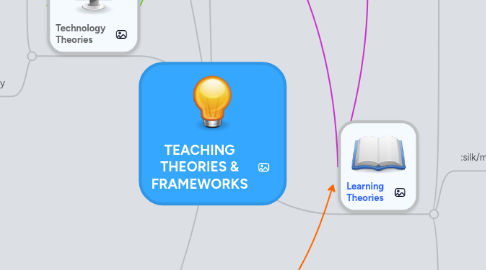
1. Technology Theories
1.1. SCOT (Social Construction of Technology)
1.1.1. Human action shapes technology - not the other way around
1.1.2. Technologies' acceptance, dismissals (success, failures) are dictated by the social world
1.1.3. Questions that are asked include: who defines the technical criteria success is measured by, why criteria is defined in the manner it is and who is included/excluded
1.1.4. Basically one has to consider the social and human context, that drove the creation of the technology in the first place
1.2. Media Ecology
1.2.1. "How media of communication affect human perception, understanding, feeling, and value; and how our interaction with media facilitates or impedes our chances of survival…”
1.2.2. Teachers need to look at how the student’s interaction with media and technology affects their thinking, feelings and behaviour - their ecosystem
1.2.3. Still very much in its infancy and viewed as a metadiscipline
1.2.4. Looks at how media can affect the roles we play; how we feel and act
2. Connectivism
2.1. Connecting and networking – a network of “nodes”
2.1.1. PLNs could be one such node
2.1.2. Learning is the process of creating connections and developing a network
2.2. Key Theorists: George Siemens and Stephen Downes
2.2.1. Learning today – properly connected so one can reach out to (one’s ability to connect is learning for George Siemens)
2.3. Basically, there is too much to know today so instead of trying learn everything, know how to access sources when you need them- anyway, what is right today may be wrong tomorrow
3. Philosophy of Teachnology
3.1. A teacher's personal philosophy of how they will integrate and utilize technology in the classroom to assist students with the learning process
3.2. Interweaves the purpose of technology with personal values and beliefs about teaching and learning
4. TPACK
4.1. Technology Knowledge
4.1.1. TCK, TPK
4.2. Pedagogical Knowledge
4.2.1. PCK, TPK
4.3. Content Knowledge
4.3.1. TCK, PCK
5. Learning Theories
5.1. Behaviourism
5.1.1. No one can be sure what is happening in a mind; it is a black box
5.1.2. Behaviour is a response to stimulus
5.1.3. The objective is to create or change a behaviour
5.1.4. Various methods, such as reinforcement, conditioning, shaping/modelling, rewards, punishments etc. are used.
5.1.4.1. Games such as Mathblaster or Farmville shape behaviours, by offering various rewards and consequences
5.1.5. Key Theorists: Pavlov, Watson, Thorndike, Skinner
5.2. Cognitivism
5.2.1. The mind is considered to be more of a computer, with active memory systems and organized processors of information
5.2.2. Prior knowledge is key: "New information is compared to existing cognitive structures called schema"
5.2.2.1. Learners categorize information (critical vs. noncritical)
5.2.2.2. Learners make comparisons (known and unknown)
5.2.2.3. Learners use devices such as mneumoics or acronyms or metaphors/symbolism
5.2.3. There is said to be a Three Staged Information Processing Model
5.2.3.1. SensoryRegister
5.2.3.1.1. Briefly enters for seconds, but not long enough to be considered STM and then then typically disappears unless moved to STM
5.2.3.2. Short-Term Memory (STM)
5.2.3.2.1. 2 to 7 minutes retention tme, which can be increased if chnaged into meaning ful parts
5.2.3.3. Long-Term Memory and Storage (LTM)
5.2.3.3.1. stores STM for LTM use, sometimes via rote memorization, deeper levels can be achieved through linkages of old and new info
5.2.4. Cognitive Load Theory - " is an information processing theory used to explain the limits of working memory based on current knowledge of human cognitive architecture"
5.2.4.1. Processing information can over or under load working memory
5.2.4.2. Things must run smoothly in order for meaningful learning to occur
5.2.4.3. Total Cognitive Load
5.2.4.3.1. Intrinsic Load (difficulty) - "caused by inappropriate instructional designs that force working memory to focus away from building schemas into long term memory"
5.2.4.3.2. Extraneous Load (simplicity) - "caused by the irreducible complexity of elements interacting in working memory"
5.2.4.3.3. Germane Load (schemas/connections) - "caused by effortful learning resulting in Schema construction and the process of automation"
5.2.5. Key Theorists: Piaget, Gagne, Vygotsky, Bruner
5.2.5.1. Examples of cognitive technology: Prezi, Databases
5.3. Constructivism
5.3.1. Idea that learning is constructed and new knowledge is built and based on old/previous information
5.3.2. Learning is active and learners have to apply their current understanding, and modify it for the new situation - they are basically active creators of their own knowledge
5.3.2.1. Collaboration is imporant, learners can bring their own perspectives to the situation
5.3.3. In the realm of teaching, active techniques are encouraged
5.3.3.1. e.g. Experiments, real-world problem solving etc.
5.3.4. Taps into a students innate curiosity, wanting to try for oneself and "teaches" students "How to Learn"
